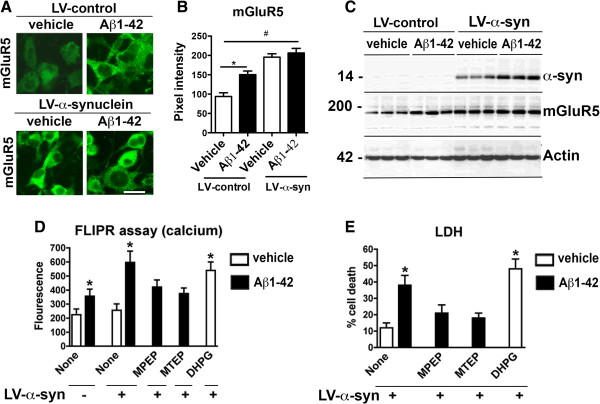Figure 9.

α-Synuclein and Aβ effect mGluR5 to promote toxicity via increase intracellular calcium flux. The co-pathogenic mechanisms of Aβ and α-syn toxicity were investigated in the B103 rat neuroblastoma cells infected with LV-α-syn and treated with Aβ oligomers. A. Immunocytochemistry, B image analysis and C. Western blot analysis of the levels of mGluR5 in B103 cells revealed the lowest levels in vehicle treated cells. mGluR5 was significantly increased in cells treated with Aβ or LV-α-syn alone; and mGluR5 levels were the highest in cells treated with both Aβ and LV-α-syn. Aβ increased levels of α-syn in cells where both were present. D. Intracellular calcium levels, as measured using the fluorescence-based FLIPR assay, revealed that Aβ treatment resulted in a two-fold increase in intracellular calcium compared to control cells. While LV-α-syn had no effect on its own, in combination with Aβ there was a three-fold increase in intracellular calcium, which was similar to the effect of treating cells with the mGluR5 agonist DHPG. Pretreating B103 cells with mGluR5 antagonists MPEP and MTEP prior to Aβ and LV-α-syn exposure attenuated the intracellular calcium increase. E. In the lactate dehydrogenase (LDH) toxicity assay, B103 cells were unaffected by LV-α-syn; however, the percent cell death dramatically increased when LV-α-syn was combined with Aβ oligomers. The mGluR5 agonist DHPG caused a similar level of cell death, while pretreatment with the mGluR5 antagonists MPEP and MTEP attenuated the neurotoxic effects and reduced cell death to levels similar to LV-α-syn alone. * = p-value < 0.05 by one-way ANOVA and Dunnett’s post hoc analysis compared to vehicle-treated control.
